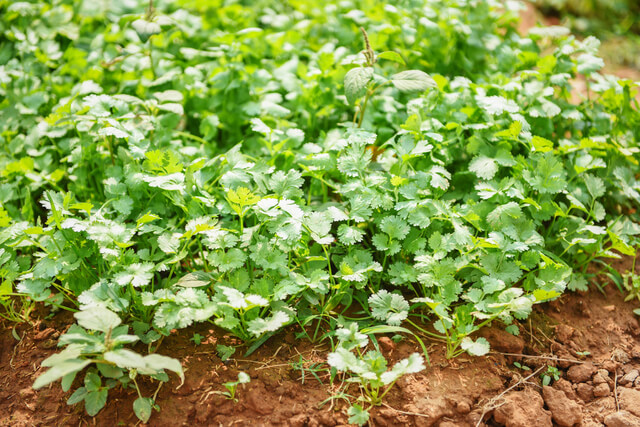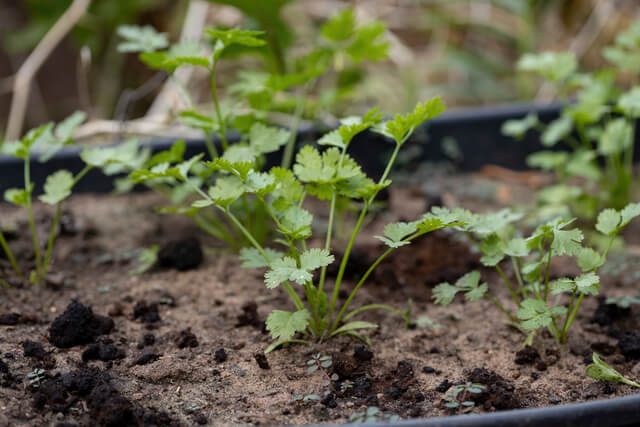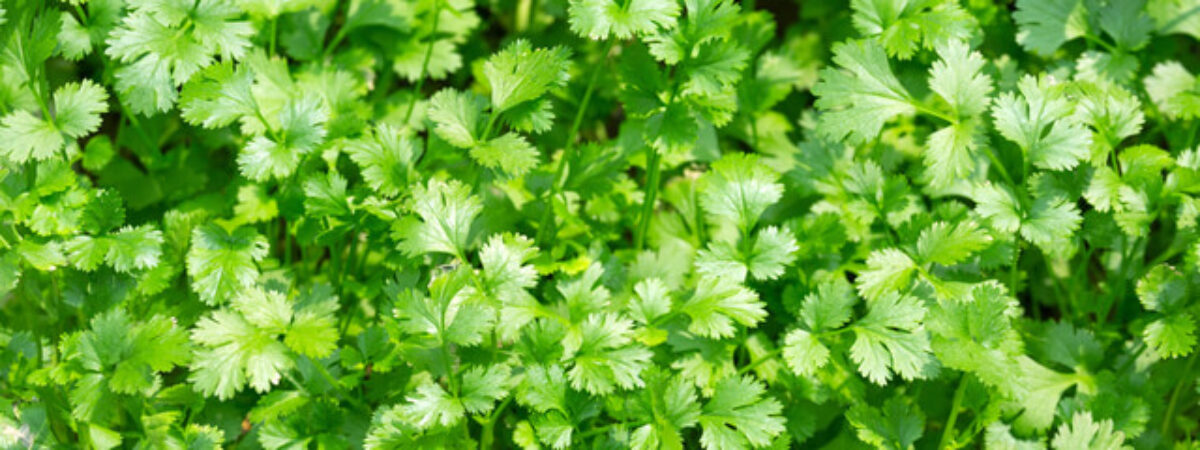Coriander or you can call it Cilantro or Chinese parsley as well, one of the most popular herbs that must be in everyone’s herb garden. In India people call it Dhaniya.
It is scientifically known as Coriandrum sativum and belongs to the family Apiaceae. Cilantro is native to Asia, Europe, Africa and grows best in USDA hardiness zone 2-11.
You can grow cilantro in containers / pots and even outside in a garden. Herbs are definitely a great addition to your garden as they add fragrance to the garden.
These are usually grown from seeds but they can also be grown from cuttings that you might have kept in the refrigerator.
Coriander seeds are of great use in the digestion process. It is also an anti food poisoning agent.
The stem of this plant is thinner and they have bright green leaves. These herbs are one of the easiest to grow and they are annual herbs.

Coriander is a staple herb in every household, and if you are from India then you can relate to me in this that we ought to have a bundle of coriander free with our vegetables from grocery shops.
But it gets difficult to have absolute fresh coriander leaves from outside, so it is better to grow it in our own space and enjoy the fresh leaves that have all the health benefits.
You can grow cilantro in containers / pots and even outside in a garden. Herbs are definitely a great addition to your garden as they add fragrance to the garden. Click To TweetHowever , being an easily grown herb, there are some basic things to grow Cilantro that need to be taken care of so that you can get absolutely fresh Cilantro and use it in your cuisine.
The best part about this is that it blends with all the cuisines whether it be in Indian, Middle Eastern or in Asian cuisines.
Here I have tried to cover every detail on how to grow this plant in pots/containers indoors.
Growing Guide
Coriander is one of the easiest herbs to grow. It grows up to a height 12 to 22 inches. They prefer mostly cool seasons so the best time to plant them is after the frost has gone completely.
Though they can grow in any climatic conditions, during summer their leaves’ development efficiency decreases a bit.
It has a very short life span i.e around 40-50 days. This herb is basically used as a rotation crop and even some gardeners like to grow this herb twice a year.
All they need is plenty of water and Sunlight but it should be indirect. Coriander can be grown from seeds as well from root cuttings.
If you are growing coriander from seeds, then remember to soak the seeds in water overnight and then start sowing them the next day.
Coriander are best grown when direct seeds are sown rather than transplanting the sprouts. For sowing seeds take a good starter mix soil with compost in a large container.
As coriander grows bushy so a large container is best and even you can grow this along with other herbs. In this way, there will be more healthy growth of herbs as they complement each other in a great way.
Place the soil in a container and then plant your seeds or your rooted stem cuttings. Don’t press the seeds too much into the soil.The seeds should be sown in a distance of 3 to 4 inches from each other.
Cover the seeds with soil and water them regularly. When you are growing coriander in a pot it requires more nutrients so add more organic matter to the soil.

Growing Coriander without seeds
Coriander can also be grown through rooted stem cuttings. The process of planting in a container is similar to that of sowing seeds.
Plant the cuttings in a container that has well drained soil with organic matter to provide adequate nutrients to the plants.
Then water the soil and keep it under indirect Sunlight space.
Growing Coriander without soil
Coriander can be grown even without soil. Plant the cuttings in a small container having water. Regularly change the water to avoid any contamination.
Regularly take out some leaves to use in your dishes, in this way it helps the plant to produce new leaves and grow healthier. This should be done in all the process of planting coriander.
Caring Guide
Soil
Coriander prefers fertile soil so a rich organic matter content in soil helps it to grow healthy. The soil should be well drained and should have a pH of 6.2 to 6.8.
The container should possess enough holes for drainage.
Light
Cilantro likes bright Sunlight but not direct Sunlight. Morning Sunshine hours are the best for corianders. So when grown indoors, placing the container in an east facing window helps the plant to get indirect Sunlight.
Temperature and Humidity
Coriander is best grown in the temperature range of 17 degree celsius to 27 degree celsius. These are cool season herbs so they get bolt easily in summer months.
However if you are planting it indoors then you can grow them easily during summer too. You need to bring the pot inside an air conditioned room where the plant can get its optimum temperature to grow.

Water requirements
Water is the major part in growing coriander. They are deep rooted herbs and hence need frequent watering during the dry periods especially.
It also requires a good drainage facility as it cannot grow well in soggy soil, so ensure that your pot has enough drainage holes.
Fertilizer
A spray of liquid fertilizer or slow-releasing fertilizers will work. But the best thing is to use compost to get chemical-free coriander leaves.
A good amount of compost will provide all the nutrients the plant need to uptake from soil and grow healthy and produce green leaves.
Coriander is best grown in the temperature range of 17 degree celsius to 27 degree celsius. These are cool season herbs so they get bolt easily in summer months. Click To TweetHarvesting
Harvesting at the young stage is best i.e when the leaves are small as they are least bitter and add freshness to your dishes.
Basically there is not a proper way to harvest these corianders, you can just pinch off the leaves daily as per your requirement.
Daily pinching off leaves can enhance more leaves growth. You can plant fresh cuttings every four to six weeks so as to get cilantro for the whole year.
Problems
Some common problems you might face while growing coriander are bolting and root rot.
Bolting
When coriander starts producing flowers directly instead of leaves then it is called bolting. This happens due to high heat or under watering conditions.
In order to avoid bolting, you need to keep the soil moist and provide adequate temperature to the plant. You can even sow a new plant every 4 to six weeks to get continuous leaves.
Root rot
As coriander has deep roots, so the roots are vulnerable to getting wet most of the time, in that case root rot develops.
So it is best to have well drained soil and the container should also have sufficient drainage holes. Avoid watering in the evening hours.
Conclusion
The leaves of the coriander plant are known to possess many health benefits, and when cut fresh they are particularly flavorful.
I hope this guide will definitely show you how to grow coriander at home since you cannot buy fresh and healthy coriander from the market.
So, What are you waiting for! Start growing coriander at your indoor garden space and enjoy its freshness and benefits to the fullest.
If you have any further queries regarding coriander then feel free to ask in the comments below.
You may also like to read
How to Plant, Grow And Care for Cuban Oregano – A Complete Guide







One thought on “How to Grow Coriander Indoors? – A Complete Guide to Grow Cilantro”
This is great. People – every household – need this information. Disregarding the place one lives, she/he can contributes to food production even at a tiny level, starting from preparing a part of her/his/family food.
Thank you for the great service.
Jayantha W